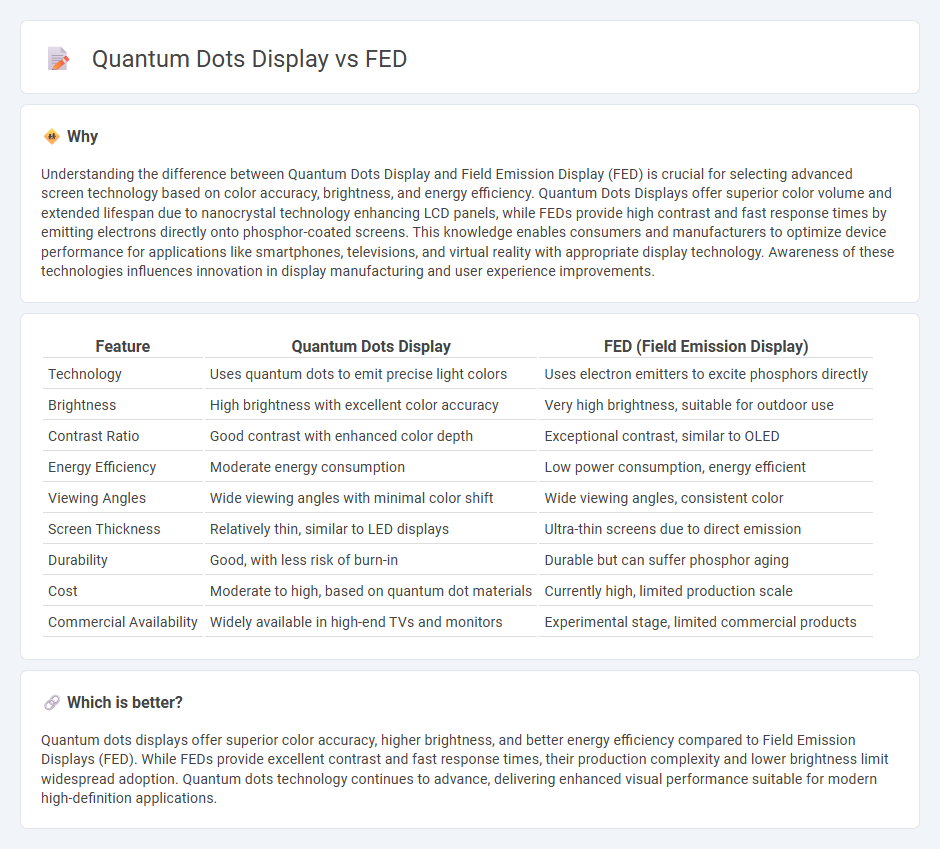
Quantum dots displays offer superior color accuracy and higher brightness levels by using semiconductor nanocrystals that emit precise light wavelengths, enhancing visual experience. Field Emission Displays (FED) rely on electron emission from a cathode to excite phosphor pixels, providing fast response times and wide viewing angles with lower power consumption than traditional displays. Explore detailed comparisons to understand which technology best suits your display needs.
Why it is important
Understanding the difference between Quantum Dots Display and Field Emission Display (FED) is crucial for selecting advanced screen technology based on color accuracy, brightness, and energy efficiency. Quantum Dots Displays offer superior color volume and extended lifespan due to nanocrystal technology enhancing LCD panels, while FEDs provide high contrast and fast response times by emitting electrons directly onto phosphor-coated screens. This knowledge enables consumers and manufacturers to optimize device performance for applications like smartphones, televisions, and virtual reality with appropriate display technology. Awareness of these technologies influences innovation in display manufacturing and user experience improvements.
Comparison Table
| Feature | Quantum Dots Display | FED (Field Emission Display) |
|---|---|---|
| Technology | Uses quantum dots to emit precise light colors | Uses electron emitters to excite phosphors directly |
| Brightness | High brightness with excellent color accuracy | Very high brightness, suitable for outdoor use |
| Contrast Ratio | Good contrast with enhanced color depth | Exceptional contrast, similar to OLED |
| Energy Efficiency | Moderate energy consumption | Low power consumption, energy efficient |
| Viewing Angles | Wide viewing angles with minimal color shift | Wide viewing angles, consistent color |
| Screen Thickness | Relatively thin, similar to LED displays | Ultra-thin screens due to direct emission |
| Durability | Good, with less risk of burn-in | Durable but can suffer phosphor aging |
| Cost | Moderate to high, based on quantum dot materials | Currently high, limited production scale |
| Commercial Availability | Widely available in high-end TVs and monitors | Experimental stage, limited commercial products |
Which is better?
Quantum dots displays offer superior color accuracy, higher brightness, and better energy efficiency compared to Field Emission Displays (FED). While FEDs provide excellent contrast and fast response times, their production complexity and lower brightness limit widespread adoption. Quantum dots technology continues to advance, delivering enhanced visual performance suitable for modern high-definition applications.
Connection
Quantum dot displays utilize semiconductor nanocrystals to emit pure and vibrant colors through precise light manipulation, enhancing image quality and energy efficiency. Field Emission Displays (FED) rely on electron emission from sharp cathode tips to excite phosphors and produce images with high contrast and fast response times. Both technologies aim to improve display performance by optimizing electron and photon interactions at the nanoscale, leading to brighter, more vivid visuals with lower power consumption.
Key Terms
Electron Emission
Field Emission Displays (FEDs) utilize cold cathode electron emission from sharp tungsten tips to excite phosphors directly, offering high brightness and wide viewing angles. Quantum dot displays rely on quantum dots' photoluminescence properties to emit pure, tunable colors with greater energy efficiency but require backlight sources or electroluminescent layers rather than direct electron emission. Explore detailed comparisons on electron emission mechanisms and performance metrics to understand which display technology suits your needs.
Quantum Confinement
Quantum dots displays leverage quantum confinement effects to precisely control light emission at the nanoscale, resulting in enhanced color accuracy and brightness compared to Field Emission Displays (FEDs). Quantum confinement in semiconductor nanocrystals allows quantum dots to emit pure, tunable wavelengths by manipulating electron-hole pairs, offering superior efficiency and longer lifespan. Explore the cutting-edge technology behind quantum dots to understand their impact on next-generation display innovation.
Color Purity
FED (Field Emission Display) technology offers superior color purity by utilizing electron beams to excite phosphors directly, resulting in vibrant and precise color reproduction with high contrast ratios. Quantum dots displays enhance color accuracy through nanocrystals that emit specific wavelengths when illuminated, providing a broader color gamut and improved color saturation. Explore detailed comparisons to understand how each technology impacts display color purity and overall visual performance.
Source and External Links
Federal Reserve - Wikipedia - The Federal Reserve System, often called the Fed, is the central banking system of the United States, created in 1913 to manage monetary policy, maximize employment, stabilize prices, and moderate long-term interest rates while also supervising banks and maintaining financial stability.
Federal Reserve Board - Home - The Federal Reserve Board oversees financial regulation, supports fintech innovation, and communicates regularly about economic outlooks and policy through speeches, press releases, and reports like the Beige Book.
FEDERAL RESERVE BANK of NEW YORK - Serving the Second ... - The New York Fed focuses on strengthening the U.S. economy and financial system stability, conducting market operations and providing regional economic data and analysis.
 dowidth.com
dowidth.com